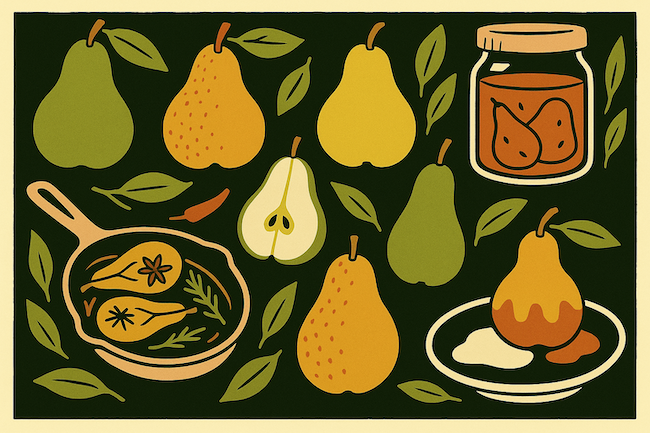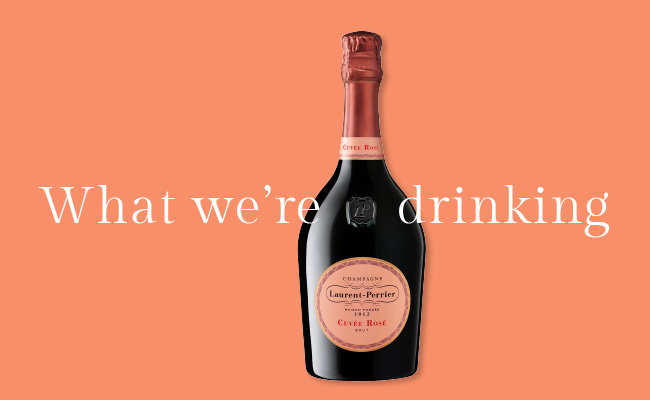As I was contemplating a bowl of pears, waiting for one to ripen, I realised that the pear gets a bad rap for its short window of transcendence.
Ralph Waldo Emerson is meant to have said that there are only ten minutes in the life of a pear when it is perfect to eat. Really? He must have had a towering compost heap. But our household still laughs at the image of comedian Paula Poundstone setting her alarm for midnight when pears are in the house, since they will only ripen sometime between then and 2.00am.
It turns out this is a common pear trope, if there are such things as fruit tropes: one must stay up all night to eat a pear, the old English saying goes. But hello, bananas? Avocados? Strawberries? And apparently it all comes down to the ethylene hormonal surge. But this is a family-friendly website, so we will not go there today.
I happen to like my pears with a little crunch – how else will they hold up in a salad with shavings of fennel and pecorino over rocket with a lemony dressing? And they must be firm for poaching. Just ask Peter Gordon, who once had a trendy Notting Hill restaurant called The Sugar Club. His poached pears have a distinct advantage over others in that they can serve as a dessert or a first course.
In a pot large enough to hold six firm, peeled pears, combine a red chilli cut in half, a bay leaf, a 6 cm rosemary sprig, 2 star anise, 2 cinnamon sticks, 3 cloves, the zest and juice of 2 lemons, 300 g caster sugar, 1 T honey and 600 ml of decent red wine. Bring to a simmer for five minutes or so and then add the pears, rolling them over a few times in their nice hot bath for another 30 minutes until they are soft. Remove the pears and reduce the liquid by half, then strain over the pears. Add a plop of mascarpone for pudding (serve warm or cold) or add extra chilli when poaching to serve as a starter with gorgonzola and greens.
“Going pear-shaped” is pretty much the same as going to hell in a handbasket or can be responsible for years of teenage angst about body type. Nevertheless, its sensuous form and mottled colours give it prominence in countless still-life paintings; two of my favourites – here and here – are by the early impressionist Edouard Manet. And apropos of nothing, did you know it is highly improbable that you might find a partridge in a pear tree? Partridges are ground-nesting birds that prefer open landscapes and are not typically seen in trees.
Pears may be less hardy than their apple and quince sisters (George Carlin calls them “failed” apples) but they can survive canning and, thank goodness, distillation into eau de vie. My grandfather grew several varietals and I remember his valiant efforts to make a drinkable pear “wine”; sadly, it was no water of life – although he was still climbing ladders to prune his orchards at 93.
Something whose flavour is as shy as that of the pear enjoys some close, quiet friendships as all introverts do. Almonds and pears are especially intimate and chic. The author of an old recipe I have for a rapturous pear and almond croissant pudding refers to it as a “bread pudding in an Armani suit”. Most cheeses share secrets with pears, and neither the floral waft of cardamom, nor cinnamon’s warmth, will overpower their friend. Prosciutto is its bestie.
I can confirm pears’ cosiness with spices – a friend and I hosted a pop-up restaurant a couple of years ago and for our final course, we served pears to 50 people. Here is the recipe divided for you so you can have them with only three chosen others and not spend a rare day off from your hectic life coring pears. Melt 30 g butter with 2 T maple syrup, half a split vanilla bean, a broken star anise, 2 bruised cardamom pods, half a cinnamon stick (broken in half) and a quarter of a teaspoon of freshly grated nutmeg. Swirl the spices around in the butter over a medium-low heat until it all bubbles and add four halved cored pears, face down, until they are golden brown on the bottom, turning now and then. Serve hot with crème anglaise for dinner, or room temperature with some yogurt for brunch.
Tannie Google says there are some 3,000 types of pears on our planet; Tru-Cape lists 15 grown in South Africa (we are, at least until tariff madness sets in, the second-largest pear exporter in the southern hemisphere after Argentina). Regretfully, it is rare to find more than three or four varieties in our supermarkets.
The Forelle is the prettiest, but the Beurre Bosc and Peckham’s Triumph taste sweetest and give savoury dishes a third dimension. The addition of dried pears to a lamb bredie gives it a little je ne sais quoi (I’ve always wanted to write that) and caramelised roasted pears and onions with halloumi taste like winter heading into spring. I make Claudia Roden’s Moroccan tagine of chicken, baby onions and pears with characteristic saffron most winters, and adding pears to a simple risotto is as satisfying as an unexpected plot twist.
Pear season is drawing to a close, so in order to get in one last pear crisp with candied ginger, it’s important to heed the advice of Pubilius Syrus, who knew, helpfully, over 2,000 years ago that, “You should go to a pear tree for pears, not to an elm.”
Sign up to Currency’s weekly newsletters to receive your own bulletin of weekday news and weekend treats. Register here.















What a delightful Sunday morning read!
Most entertaining and informative!